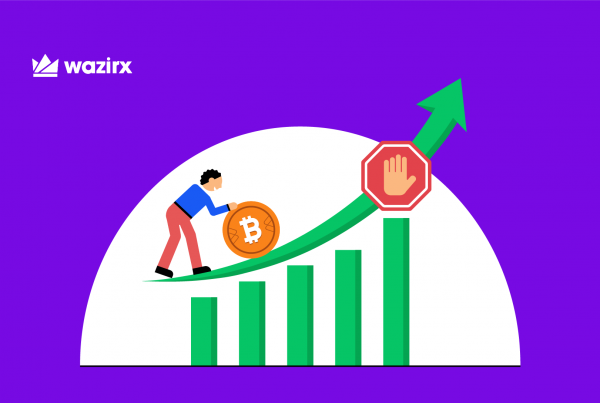Table of Contents
What happens when you sell your Cryptocurrencies for a profit at their respective all-time highs price during a bull market? You rejoice and celebrate as a result of the fact that you made some hefty profits. However, on the contrary, what you don’t think of is the buyer on the other end of your trade that bought the all-time high. While you celebrate, what should the buyer do? Should he panic about buying the top? That’s hardly the case.
Perhaps at one point, you were in the same standing as the buyer when you bought into your position. You might have bought the 2017 top without your knowledge, but you managed to sell it for a profit during the bull run that followed. What we can infer from this scenario is that while the present conditions might be rough, if you are patient and disciplined enough, you’ll definitely make it.
What’s startling is how many individuals are complaining about losing money on cryptocurrency in recent weeks. If you made some risky decisions or succumbed to FOMO and staked the house on it, you’ll have to accept responsibility. Bear markets are not a new phenomenon. Bitcoin has collapsed multiple times in the past, as is well known. The old adage “it’s not about timing the market, it’s about how much time you spend in the market” applies equally to cryptocurrency.
So, looking at the past several days, it may appear to be a crash. But if you go back far enough, cryptocurrencies are still on the rise.
This is not the first and not the worst Bear Market
Bear markets are an unavoidable element of every economic cycle; every period of repeated highs is inevitably followed by a period of fall, no matter how brief or lengthy.
99% in June 2011
Bitcoin skyrocketed from $2 to more than $32 in 2011, reaching parity with an ounce of silver. Then the bottom fell out. Mt. Gox, the world’s largest Bitcoin exchange, admitted on June 19 that hackers had accessed several accounts and stolen millions of dollars in Bitcoins. In just one day, the value of a Bitcoin dropped to one cent.
[wd_hustle id="4" type="embedded"/]56% in August 2012
In August 2012, the community found out that a traditional Ponzi scam modified for the digital age had been defrauding cryptocurrency investors for months. The perpetrator — ultimately accused, convicted, fined, and imprisoned — had taken 700,000 Bitcoins by fraud, promising amazing profits of 7 percent monthly interest.
83% in April 2013
Bitcoin became a victim of its own success in 2013, as investors raced on to the exciting new prospect that was spreading in the mainstream media. Trading traffic was so high that Mt. Gox couldn’t keep up, and when it crashed, hackers took advantage of the vulnerability. It led Mt. Gox into an unprecedented complete closure, with prices plummeting from roughly $260 to $50.
50% in December 2013
According to the Guardian, when China banned Bitcoin at the end of 2013, its value dropped by half overnight. China’s relationship with cryptocurrencies remains unstable, with the authorities implementing new restrictions on a regular basis.
84% between December 2017 and December 2018
In 2017, Bitcoin had a historic year, shattering all of its own records and reaching a high of $20,000. Then, on December 27, everything fell apart as speculators cashed in on what was clearly a bubble, bringing the price below $12,000. The cryptocurrency would continue to fall throughout 2018, as major hacks in Korea and Japan, as well as rumors that both countries were preparing to outlaw Bitcoin, led already apprehensive investors to flee.
50% in March 2020
Bitcoin was not spared by the epidemic, and when the markets plummeted in March 2020, the Bitcoin market crashed even more. Bitcoin’s value fell by 50% in just 2 days. Over the course of a month, it dropped from above $10,000 in February to below $4,000 in March.
53% in May 2021
In April, one Bitcoin was worth almost $64,000. Then, in one week, $1 trillion was wiped out of the crypto market. Major hacks in Korea and Japan, as well as speculations that both governments were preparing to outlaw Bitcoin, led investors to quit. First, Elon Musk abandoned his commitment to accept Bitcoin as payment for Tesla vehicles. Then China announced another cryptocurrency crackdown. Finally, the public became aware of the environmental effect of Bitcoin mining, leaving crypto investors in a familiar situation – at the mercy of factors beyond their control.
While many new investors fear a potential bear market, those who have seen multiple market cycles and have some expertise under their belts are bracing for a buying frenzy. And, contrary to popular belief, bear markets typically provide some of the finest buying opportunities.
Cryptocurrency markets are typically volatile, which works both for and against investors. They are also significantly influenced by waves of FUD and FOMO, which can cause unpredictable price swings, times of cascading loss, and moments of stratospheric growth.
This creates possibilities for savvy traders who can recognize and exploit trends in market structure, as well as benefit from the often predictable market volatility caused by changes in supply and demand.
However, bear markets can be frightening for rookie traders. After all, no one enjoys the prospect of possibly significant losses on investments, even if these losses are frequently temporary if the investment survives the bearish period.
Reasons to be Bullish in Bearish times
The cryptocurrency market seems to be rebounding after a challenging few months. Once the worst is over, there are numerous reasons to be optimistic about crypto.
Significant Growth Prospects
While cryptocurrencies are frequently discussed in the mainstream media, the reality is that most cryptocurrencies are more than just digital money contending with fiat.
Unlike traditional money, they not only represent the expansion of the blockchain ecosystem that supports them, but they also provide control over them in a manner comparable to stock, as well as a number of features, security, and currencies that Fiat simply cannot offer.
Major Networks are Getting Major Updates
Some of the industry’s most important projects, including Cardano, Polkadot, and Solana, are set for an upgrade in the near future. These enhancements, which are set to be released this year, are intended to boost adoption.
Ethereum, the second-largest blockchain network, is currently working on Ethereum 2.0, a major network update.
Concerns about the environment are being addressed
Concerns about the environmental effect of mining have been a big source of pain for the crypto sector in recent years. With Ethereum moving to a proof-of-stake consensus and organizations like the Bitcoin Mining Council forming, sustainable crypto mining appears to be on the horizon.
The popularity of NFT is rising
Non-Fungible Tokens have been an important component of pop culture in recent years, as celebrities and organizations have begun to join the ecosystem. Marvel Comics and Fortune magazine were among the most recent to reveal NFT collections, with British auction house Christie’s also expressing an increased interest in the technology.
Crypto Has the Support of Regulators
Despite a last-minute attempt to modify the Infrastructure Bill submitted to the United States Senate, the cryptocurrency industry received widespread support from politicians in the United States. In India, regulators went ahead to implement a tax slab for cryptocurrencies, with sources claiming that a bill that aims to regulate cryptocurrencies is underway. All of this goes to demonstrate how regulators all across the globe have softened their stance regarding cryptocurrencies.
Institutional Support is on the rise
Despite the concerns, the cryptocurrency and blockchain sector is expanding. Much-needed financial architecture is being developed, and institutional-grade custodial services are becoming more accessible to investors. Professional and individual investors are progressively gaining access to the tools they need to manage and protect their crypto holdings.
Crypto futures markets are emerging, and many institutions are gaining direct exposure to the cryptocurrency market. Block and PayPal are making it simpler to buy and trade cryptocurrencies on their popular platforms. Other firms, including Block, have invested billions of dollars in Bitcoin and other digital assets. In early 2021, Tesla acquired $1.5 billion in Bitcoin. By February 2022, the electric car manufacturer claimed holding about $2 billion in bitcoin. Since 2020, MicroStrategy, a business intelligence software firm, has been acquiring Bitcoin. By the end of 2021, it had $5.7 billion in cryptocurrencies and stated that it intends to buy more with extra revenue earned from operations. This trend has continued this year as well.
Although multiple parameters continue to influence the volatility of cryptocurrencies, the growing rate of adoption is a symptom of an industry maturing. Both investors and corporations are seeking direct exposure to cryptocurrencies, believing it to be safe enough to invest large amounts of funds.
Take this time out to Strategize
By now, you must have gotten the idea that bear markets are part of the market cycle and will eventually come to an end. Hence, such volatile periods are a good time to reflect upon your trading strategies and prepare for the upcoming bull run.
Study why the market is dropping
You should know why prices are falling in case it affects your investing strategy. If your rationale for investing remains valid, it is fine. But if something has radically changed, such as a security incident, and you no longer trust a certain project, it’s a different issue.
Assume you purchased a cryptocurrency because you believe the underlying blockchain technology would transform a certain sector. Rumors that quantum computing breakthroughs have rendered that technology obsolete cause the price to plummet. If such reports are true, it may be time to reconsider your investment; your rationale may no longer be valid.
Don’t panic-sell
When the value of your cryptocurrency investments falls, it is normal to want to reduce your losses and sell your holdings. However, this frequently means that you sell at a low and miss out on any subsequent rebound.
Assume you notice the price of Bitcoin declined by 20% and decide to sell your holdings. What if the price suddenly returns to its former level? You’ve lost 20% and may be hesitant to buy it back.
In the short term, you never know what prices will do. They may continue to plummet, but they may also rapidly rise. So believe in your original research and investing concept. If you believe in the long-term potential of your cryptocurrency investment, you should be optimistic that the price will rebound.
Consider buying the dip
People speak a lot about buying at lows and selling at highs, but it’s almost impossible to time the market in this way. That’s one reason why many opt for a long-term investing strategy: if you only acquire assets that you believe will do well in the next five to ten years, short-term price changes are less of a concern.
On the other hand, significant dips may give an opportunity to acquire more of your preferred tokens at a low price. For example, you may have had tokens on your watchlist for some time and were waiting for the appropriate time to buy them. You could also want to acquire more of the particular tokens you already hold if you believe they have significant long-term potential.
However, don’t fall into the trap of panic buying. It’s pointless to buy something you haven’t researched and don’t actually desire just because it’s on sale. It’s also not a smart idea to spend the money you need to fulfill other financial goals (or, worse, borrow money) to buy the dip. Crypto investments remain unpredictable, and there are many unknowns, particularly as the possibility of greater regulation looms. You may try to buy the dip only to see prices drop even further.
Closing note
Keep in mind that cryptocurrency markets typically transfer funds from the impatient to the patient. Those who abandon their positions early or on a hunch will, on average, lose against those who utilize a well-thought-out and long-term focused trading approach. Bear markets magnify this disparity, benefiting those who have a strategy while penalizing those who don’t. So long story short, if you are well prepared and don’t panic, bear markets should be more of an opportunity rather than a problem.
 Disclaimer: Cryptocurrency is not a legal tender and is currently unregulated. Kindly ensure that you undertake sufficient risk assessment when trading cryptocurrencies as they are often subject to high price volatility. The information provided in this section doesn't represent any investment advice or WazirX's official position. WazirX reserves the right in its sole discretion to amend or change this blog post at any time and for any reasons without prior notice.
Disclaimer: Cryptocurrency is not a legal tender and is currently unregulated. Kindly ensure that you undertake sufficient risk assessment when trading cryptocurrencies as they are often subject to high price volatility. The information provided in this section doesn't represent any investment advice or WazirX's official position. WazirX reserves the right in its sole discretion to amend or change this blog post at any time and for any reasons without prior notice.










